What volcano destroyed Pompeii? The story of the ancient city of Rome
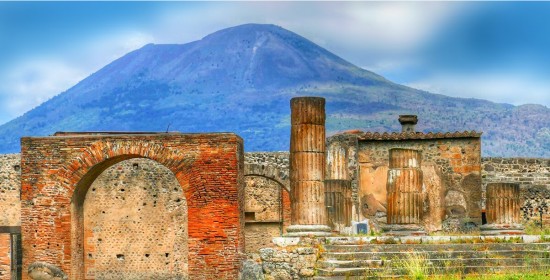
Buongiorno and welcome to Stefano’s RomeCabs, Italy’s premier tour company for tours to Pompeii and Amalfi Coast from Rome, and Shore excursions from Naples. Pompeii, Herculaneum, and Mount Vesuvius are among the most sought-after destinations in Italy for day trips and shore excursions. And for good reason: they share an impactful history that altered their existence forever.
On average, about 2.5 million tourists visit Pompeii each year making it one of Italy’s top recipients of intrigued travelers. One could never imagine that any city destroyed by a volcano would become so globally renowned after being entombed and forgotten for more than 1,500 years. But Pompeii is not just any city, and Mount Vesuvius is not just any volcano. If you’ve never experienced walking through the ancient Roman city of Pompeii or hiking the majestic Mount Vesuvius, you should consider dedicating at least one trip to Pompeii or Mount Vesuvius in your lifetime.
One could easily write volumes about Mount Vesuvius and Pompeii. But in this travel blog, we will focus on key facts and history of Mount Vesuvius and Pompeii for a better understanding of these sites before your planned visit (or if you are simply curious to learn more).
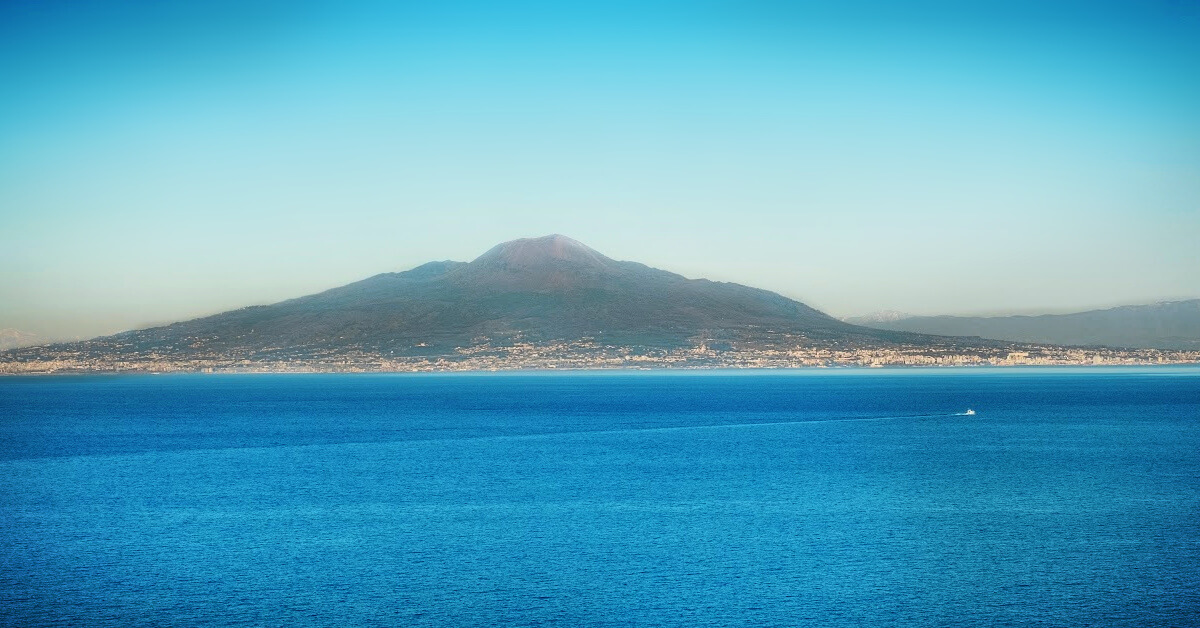
We will answer the following commonly asked questions that tell the story of the ancient city of Rome and the volcano that destroyed it:
Facts and History of Mount Vesuvius:
-
Where is Mount Vesuvius Located
-
What kind of volcano is Mount Vesuvius
-
How old is Mount Vesuvius
-
How tall is Mount Vesuvius?
-
When did Mount Vesuvius Erupt
-
Is Mount Vesuvius still active today? And is Vesuvius likely to erupt again?
Pompeii: its history, destruction, and future:
-
Brief History of Pompeii
-
What was Pompeii like before the eruption of Mount Vesuvius?
-
How did Mount Vesuvius Destroy Pompeii
-
How was Pompeii rediscovered?
-
What can be learned about Ancient Roman life from the ruins of Pompeii?
-
How did Pompeii influence the world?
-
The future outlook for Pompeii
What is Mount Vesuviuslike today:
-
What grows on Mount Vesuvius
-
Is Mount Vesuvius still active today?
-
Is Vesuvius likely to erupt again?
-
Can I hike to the top of Mount Vesuvius for a visit?
What volcano destroyed Pompeii? The story of the ancient city of Rome
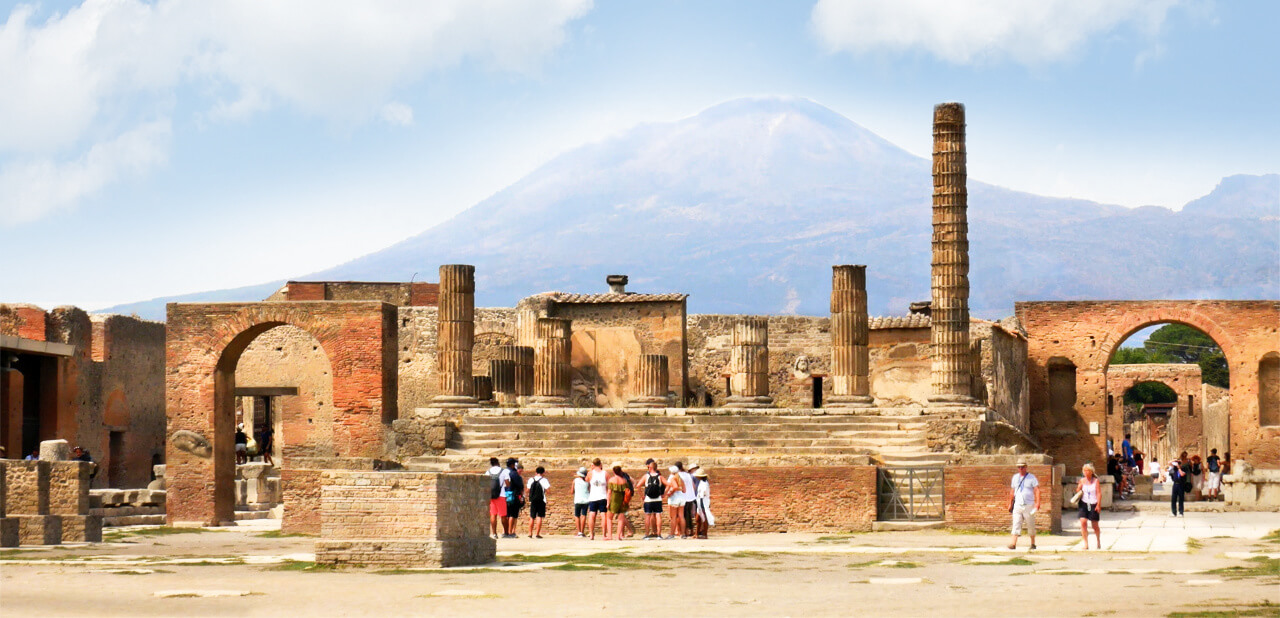
Mount Vesuvius is a stratovolcano famous for instantly decimating an entire local civilization and turning it to ash when it erupted in 79 AD. Its eruption into the stratosphere, one of the deadliest in Europe’s history, ejected molten rock, pulverized pumice, and hot ash at 1.5 million tons per second, releasing 100,000 times the thermal energy of both atomic bombings of Hiroshima and Nagasaki, burying the destroyed cities and their dead inhabitants for centuries lost to the ages. During an eruption, the temperature near Vesuvius could have reached 930°F (500°C). Pompeii was frozen in time forever preserved by the very force that destroyed it.
Pompeii’s discovery began with archaeological excavations in the late 1700s, revealing much about the lives and deaths of its ancient inhabitants. To date, excavations and new discoveries still continue.
Where is Mount Vesuvius Located
Mount Vesuvius is located on the west coast of Italy overlooking the Bay of Naples and the City of Naples.
What kind of volcano is Mount Vesuvius
The volcano is classified as a complex stratovolcano due to its unpredictable and dangerous eruptions that typically involve explosive emission of andesite lava as well as pyroclastic flows. A pyroclastic flow is a high-density mixture of hot lava rocks, pumice, ash, and volcanic gas.
Vesuvius volcano is part of the Campanian volcanic arc that formed over a subduction zone created by the convergence of the African and Eurasian tectonic plates. This subduction zone also reaches the length of the Italian peninsula and is the source of other famous volcanoes like Mount Etna and Stromboli.
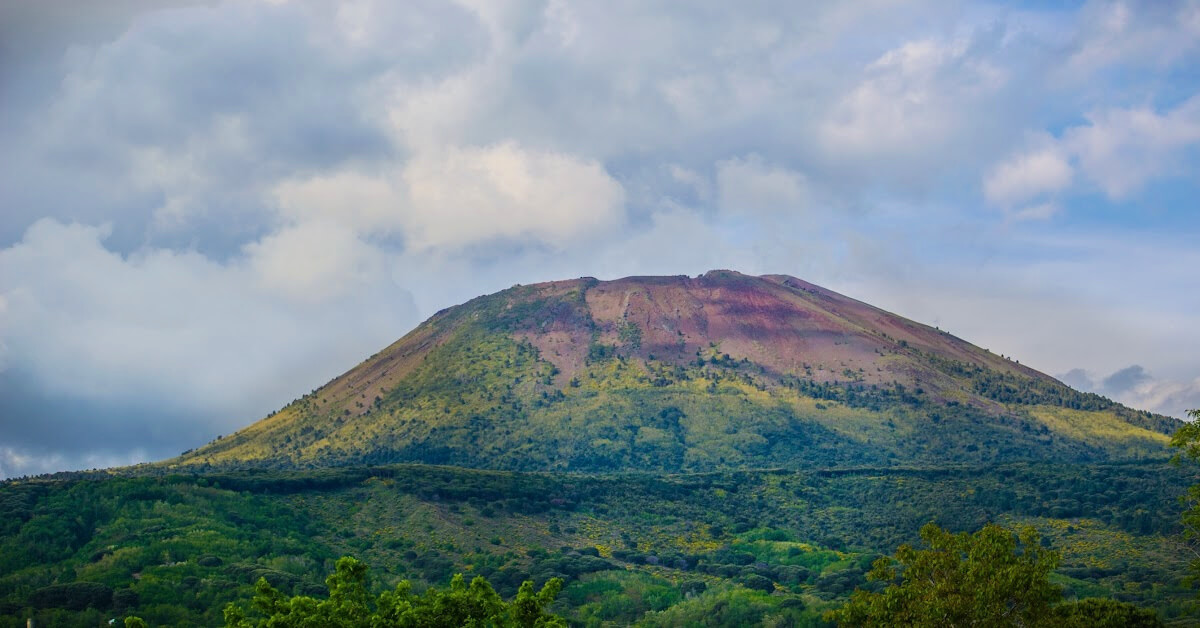
How old is Mount Vesuvius?
The cone known as Mount Vesuvius sits in the crater of the ancient Somma volcano which last erupted about 17,000 years ago. The oldest dated rock at Mount Vesuvius collected from a well drilled near the volcano is about 300,000 years old.
How tall is Mount Vesuvius?
In 2013, the height of the cone was 4,203 feet (1,281 meters). The height can change and vary after each major eruption.
When did Mount Vesuvius Erupt?
In regards to Pompeii, it has been traditionally believed Mount Vesuvius erupted on August 24-25, 79 AD according to letters written by Pliny the Younger.
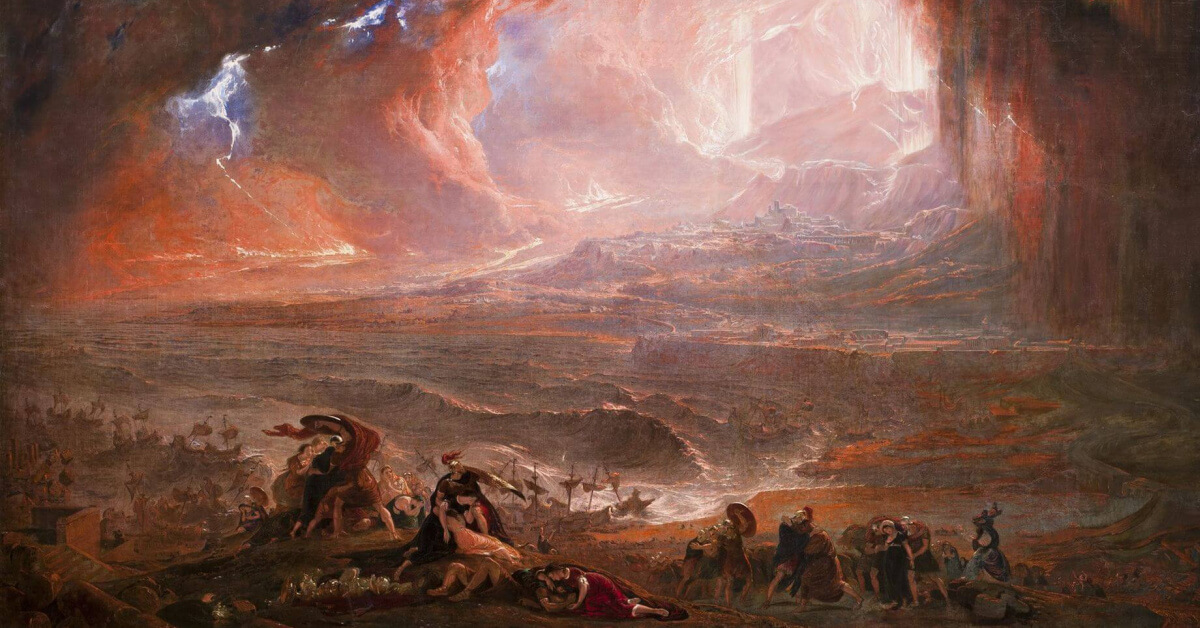
Modern hypothesis places the eruption in October or November of 79 AD. Why? Scholars argued that heavy clothing worn by some of the citizens still visible in plaster casts and braziers used for both cooking and heating may not have been used in the summer. And late August is quite hot in southern Italy.
Conflicting evidence that supports both August and autumn dates was also discovered in local foods. For example analysis of garum (the ancient fish sauce) found in Pompeii supported the traditional date in August because the fish from which garum was made was more abundant in the summer. On the other hand, autumn fruits like pomegranates and walnuts were also discovered.
Even more interesting, a charcoal inscription discovered in new excavations was dated 16 days before the “calends” of November in the old Roman calendar style, which translates to October 17 in our modern calendar. Could it have been scribbled the year before the eruption? Perhaps. But since the inscription was made in fragile charcoal that could not have lasted long on a wall, it gives it the probability that it was made in 79 AD just before the eruption.
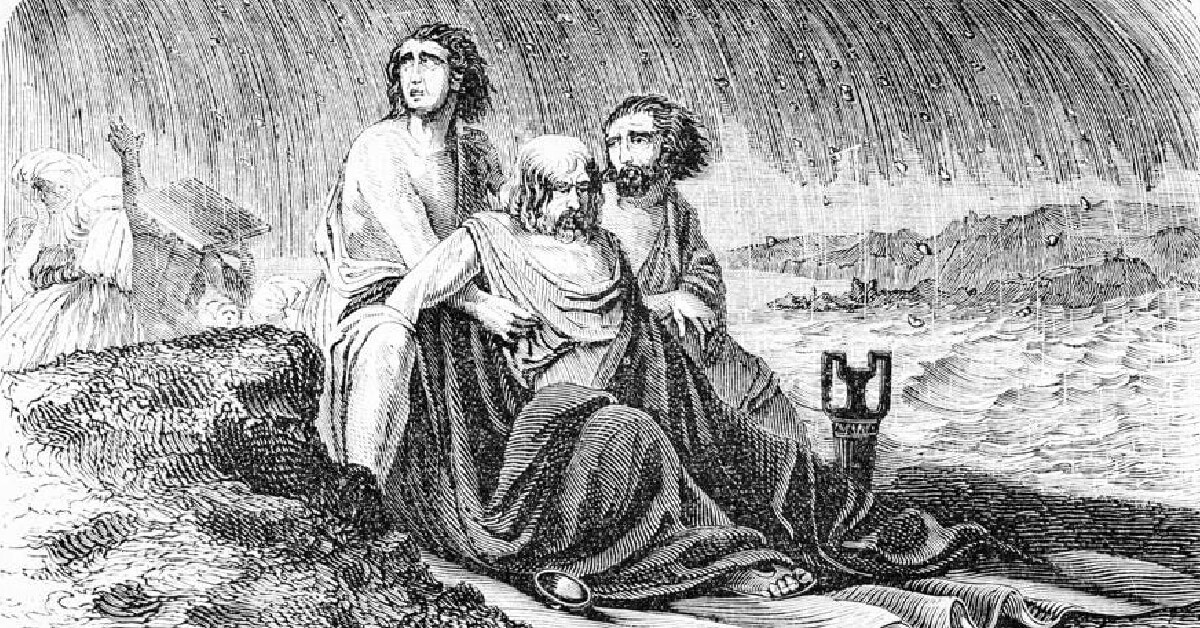
The question remains: how could Pliny the Younger have been wrong when he wrote the eruption that occurred on August 24? He wrote his letters to Tacitus approximately 20 years after the 79 AD eruption, and the original copies of the letters have not survived. Our contemporary reading of Pliny’s letters is based on translations and transcriptions made over the centuries. Although various copies of these letters contained dates ranging from August to November, August 24 was the most accepted date. The difference in dates could have been the result of confusion over the ancient and modern systems of counting days.
The balance of these discoveries leans towards the date of the Mount Vesuvius eruption being October 24 instead of August 24.
How often does Mount Vesuvius erupt?
Archeologists recently discovered that approximately 3,780 years ago, Vesuvius erupted with even more destructive power. Referred to as the Avellino eruption, Vesuvius transformed thousands of miles of the landscape into a desert for more than 200 years. Archeologists discovered deeply embedded footprints in the surrounding area where inhabitants were clearly taken by surprise when Vesuvius erupted.
Since the fateful eruption in 79 AD, Mount Vesuvius erupted about three dozen times.
A major eruption occurred in 1631 killing 4,000 people and devastating Naples and other villages.
Most recently, Vesuvius erupted between 1913-1944. On March 17, 1944, a two-week-long eruption began with lava flowing from the summit of Mount Vesuvius. The eruption caused minor damage but killed 26 people.
Is Mount Vesuvius still active today? And is Vesuvius likely to erupt again?
Vesuvius is the only active volcano on Europe’s mainland and is considered one of the world’s most dangerous. Vesuvius sits on top of a layer of magma deep in the earth that measures 154 square miles. Scientists expect that the next eruption would be an incredibly forceful plinean explosion recognized by flying rock and ash at speeds of up to almost 100 miles per hour. Given its destructive potential, Mount Vesuvius could endanger more than 3 million people in the area and decimate the city of Naples.
While Vesuvius has not erupted since 1944, it is still an active volcano, and it will erupt again. And it could be devastating for the 800,000 people who live in the “red zone” communities around Vesuvius.
Vesuvius Observatory monitors seismic activity, gas emissions, and other indicators 24 hours a day to know at the earliest point when the volcano might erupt.
Because of the unpredictable threat of an eruption, the Italian government has devised an evacuation plan to clear out the red zone 72 hours before an impending eruption. Experts warn that emergency plans should also include the city of Naples since a volcanic explosion could spew dangerous burning ash and pumice as far as 12 miles.
Brief History of Pompeii
Unlike the other cities in the region of Campania that were founded primarily by Greek colonists, Pompeii was settled by the Oscans long before it was established in 600 BC. The fertile nature of this volcanic territory increased the development of the local agricultural economy. Eventually, Pompeii came in contact with the nearby Greek colonies whose way of life, culture, and religion of Magna Graecia was quickly absorbed into its own.
In the meantime, Rome had begun its gradual advance towards the southern Italian peninsula defeating the resistance of the Italic peoples who had settled in this region. After long and bitter wars between 298 and 290 B.C. that resulted in the conquest of Campania, Pompeii also fell under Roman dominion, becoming an "associate".
This status afforded Pompeii local autonomy while from that point forward Pompeii was closely connected with Rome. Latin replaced Oscan as the official language of Pompeii, and the city soon became Romanized in its institutions, architecture, and culture. Rome’s most distinguished citizens enjoyed sojourns along the beautiful coastline of Campania that flourished as a resort for the wealthy with elaborate villas and houses.
What was Pompeii like before the eruption of Mount Vesuvius?
By the turn of the first century A.D., the population of Pompeii was estimated at about 12,000, and perhaps as many in the surrounding region. Pompeii thrived near the base of Mount Vesuvius at the Bay of Naples.
Visitors, locals, and slaves bustled in and out of small factories and artisans’ shops, taverns, cafes, marketplaces, brothels, and bathhouses. Spectators gathered in the 20,000-seat arena, and people lounged in the open-air squares or visited temples.
Merchants and manufacturers thrived with the port allowing the export of food products, cosmetics, and more. Professionals were usually grouped in corporations with a significant impact on local administration and policy. Among the most common occupations in Pompeii were bakers (pistores), washers (fullones), taverns (thermopolia), textile and leather factories (officinae coriarorium), smiths (faber), carpenters (lignarius), barbers (tonsor), marble workers (marmorarius), goldsmiths (aurifex), and more.
Farmers thrived from the rich soil of the region with an abundance of vineyards and orchards. No one suspected that the black fertile earth they relied on was the byproduct of Mount Vesuvius’ earlier eruptions.
(Although this video was filmed in Ostia Antica, it offers a glimpse into daily life of an Ancient Roman City)
During Roman times, a fermented fish sauce named garum was one of the most commonly consumed condiments in the local diet. A working-class neighborhood Pompeii was lined with fish sauce vats where hundreds of laborers and slaves produced this popular delicacy. Historians tell us that globalization struck also the ancient city of Pompeii when large-scale garum manufacturers from Spain producing large quantities at lower prices flooded the Italian peninsula and put many small-scale local suppliers out of business.
Pompeii boasted a complex water system, an amphitheater, gymnasium, baths, a port, and about 100 streets. Visitors today can still walk along the narrow ancient streets of Pompeii with elevated stepping stones that served modern-day crosswalks. These stepping stones were tall enough to keep Pompeian's feet dry from rainwater as they crossed the street but were low enough for the large carts to pass over them unhindered.
How did Mount Vesuvius erupt?
A precursor for the eruption in 79 AD was a strong earthquake that occurred in 62 AD. This was recorded in a biography of Nero and by Tacitus (one of the greatest Roman historians) as the earthquake occurred when Nero was performing for the first time in a Naples public theater. Significant damage occurred in both Pompeii and Herculaneum as a result of this powerful earthquake, and restorations were still incomplete by 79 AD.
Pompeians had long learned to live with their volatile environment, and in spite of this great earthquake people still flocked to this region, and Pompeii grew in population each year.
Then, small earthquakes were felt for 4 days before the infamous eruption took place. Unfortunately, the quakes were largely ignored as the locals were accustomed to minor tremors in the region. Underground water sources were also running out a few days prior to the event. As Pliny the Younger wrote, they "were not particularly alarming because they are frequent in Campania". Pliny the Younger was a lawyer, author, and magistrate of Ancient Rome, and the nephew of Pliny the Elder who was well regarded as a prominent Roman author, philosopher, and at the time of Vesuvius’ eruption he was also a commander of a Roman fleet in Misenum.
Pliny the Younger witnessed the eruption in 79 AD and recounted the eruption thusly in his letter to Tacitus many years later:
"At that time [24 August AD 79] my uncle was at Misenum in command of the fleet. About one in the afternoon, my mother pointed out a cloud with an odd size and appearance that had just formed. From that distance it was not clear from which mountain the cloud was rising, although it was found afterwards to be Vesuvius. The cloud could best be described as more like an umbrella pine than any other tree, because it rose high up in a kind of trunk and then divided into branches. I imagine that this was because it was thrust up by the initial blast until its power weakened and it was left unsupported and spread out sideways under its own weight. Sometimes it looked light coloured, sometimes it looked mottled and dirty with the earth and ash it had carried up….”
In these letters, Pliny the Younger referenced his uncle Pliny the Elder having had rushed ashore from Misenum to ascertain the cause of the unusual cloud formation of the volcanic phenomena and to rescue a friend and his family by ship. "Fortune favours the brave", he is believed to have said, "take me to Pomponianus" who lived in Stabiae across the Bay of Naples. He was consequently overcome by the fumes from the volcanic activity he died at Stabiae.
Modern volcanologists use the term “Plinian” to describe large-volume violet eruptions that produce quickly-expanding clouds of rock, ash, and gases that rise upward into the atmosphere. A recent example of “Plinian eruptions” includes Mount St Helens in 1980.
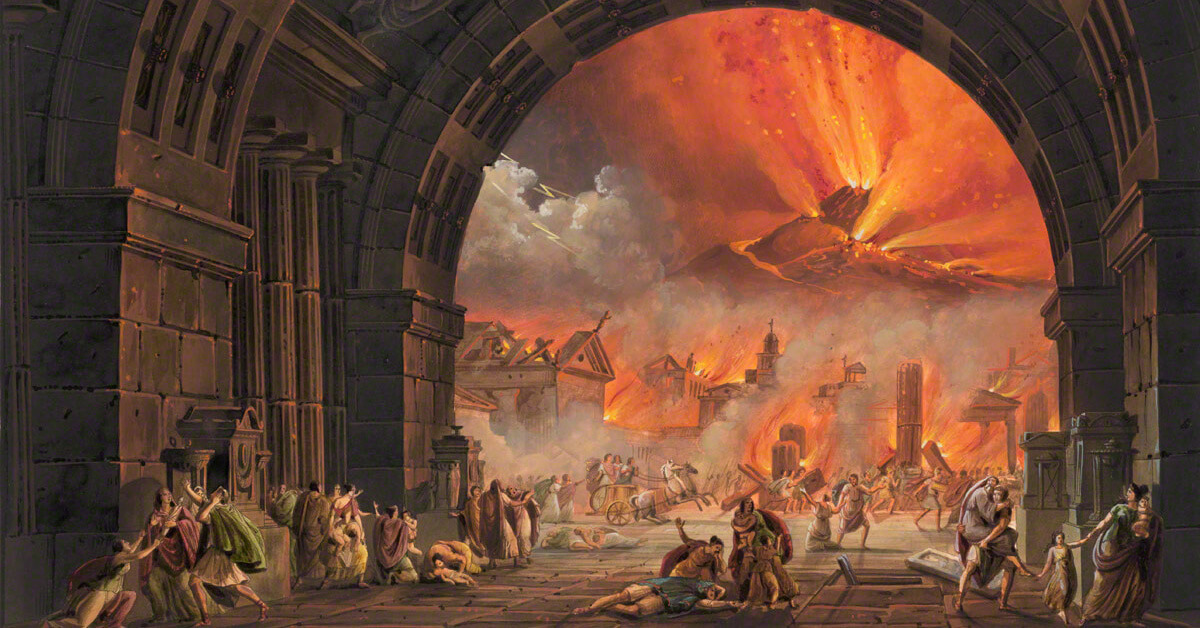
How did Mount Vesuvius Destroy Pompeii?
Mount Vesuvius destroyed the city of Pompeii in two days (approximately 25 hours), quickly burying the city in volcanic ash, well preserving that brutal moment as a snapshot of life in a Roman city.
Just after midday on August 24, A.D. 79, explosions and eruptions began, sending a tall cloud of lava and ash into the sky blocking the sun. Violent tremors caused buildings to crumble.
Pliny the Younger recalled in this letter: The darkness came back and ash began to fall again, this time in heavier showers. We had to get up from time to time to shake it off, or we would have been crushed and buried under its weight. I could boast that I never expressed any fear at this time, but I was only kept going by the consolation that the whole world was perishing with me.”
At that time, most Pompeiians still had time to flee but many did not. For those who remained behind, conditions soon grew worse. The falling ash choked the air making it difficult to breathe. Buildings collapsed under the weight.
Pliny the Younger wrote: “You could hear the shrieks of women, the wailing of infants, and the shouting of men; some were calling their parents, others their children or their wives...”
Fragments of ash, pumice, and other volcanic debris poured down on Pompeii swiftly covering the city, trapping people in their houses, and causing roofs to collapse.
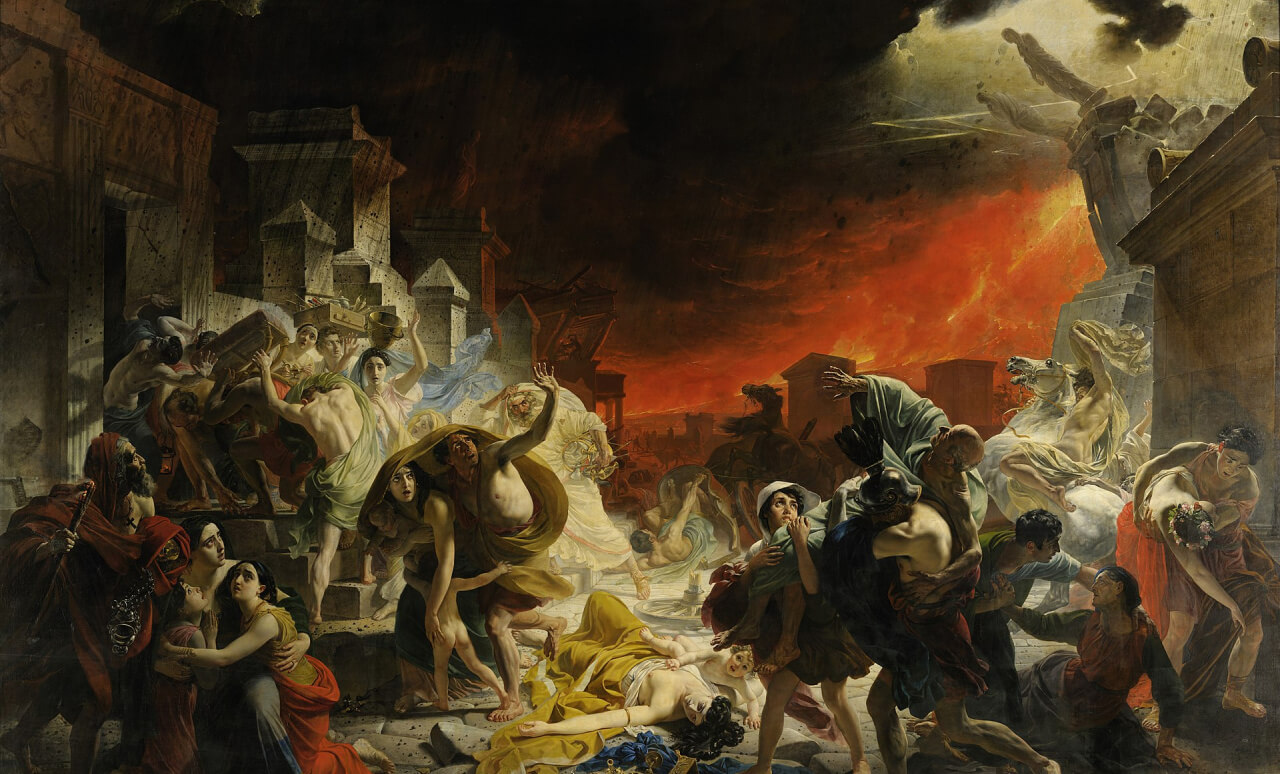
By the next morning, a 100-mile-an-hour pyroclastic surge sent rock and clouds of superheated gas down the mountainside swallowing everything in its path until it reached Pompeii and asphyxiated the surviving residents who have not fled. Research suggests it took about 15 minutes to kill the inhabitants and bury Pompeii 6-7 meters beneath millions of tons of volcanic ash. The wealthy Roman city of Pompeii (along with the nearby Herculaneum) was almost erased from history.
It is believed most victims died instantly as the superheated air burned their lungs and contracted their muscles, leaving the bodies in a semi-curled position to be swiftly entombed in a pall of ash.
Although the total death toll remains unknown it is estimated that about 2,000 Pompeiians have died. The eruption, however, may have caused more than 16,000 people to perish overall.
Survivors who managed to escape in time may have returned back in search of lost relatives or personal belongings, but there was nothing left to find. Pompeii, buried along with the nearby town of Herculaneum, was abandoned and lost to time. The sudden burial of these cities protected them for 17 centuries undisturbed from looting, vandalism, and the destructive forces of nature.
How was Pompeii rediscovered?
Throughout the Medieval Era, this deserted area was referred to as “La Civita” (The Settlement), perhaps inspired by folk tales of Pompeii’s ancient existence.
The ruins of Pompeii were first discovered late in the 16th century of the Renaissance Era by Italian architect Domenico Fontana who was excavating a canal in the area while working on new constructions. When an inscription of “Pompei” was discovered, it was erroneously attributed to the Roman general Pompey the Great, and further explorations were abandoned.
Focus on Pompeii did not begin until 1748 when early excavations revealed an amphitheater and an inscription identifying the site as Pompeii: REI PUBLICAE POMPEIANORUM.
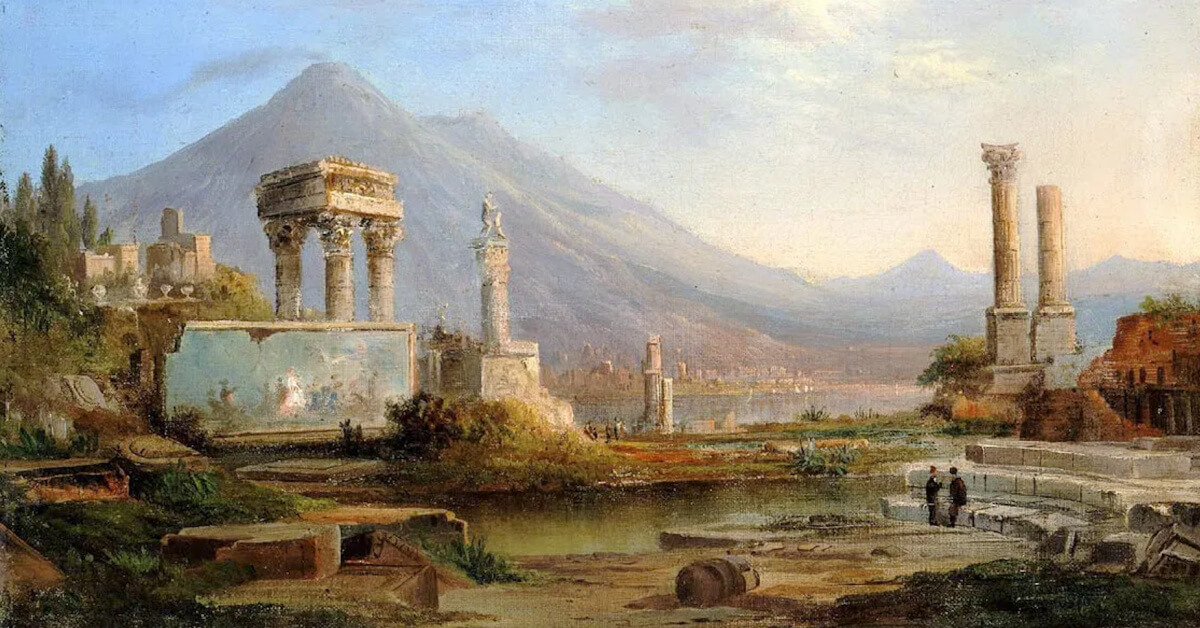
In 1755 King Charles of Naples inaugurated a Royal Academy in Naples dedicated to discoveries in Pompeii. Swiss engineer, Karl Jakob Weber, took command of the excavation efforts in Pompeii bringing forth more cautious methods of excavation than the prior haphazardous digging by untrained workers and treasure seekers. This marked the start of the modern science of archaeology and inspired European fervor for classical antiquity, with intrigued Grand Tour travelers from Britain making their way to Pompeii and Herculaneum.
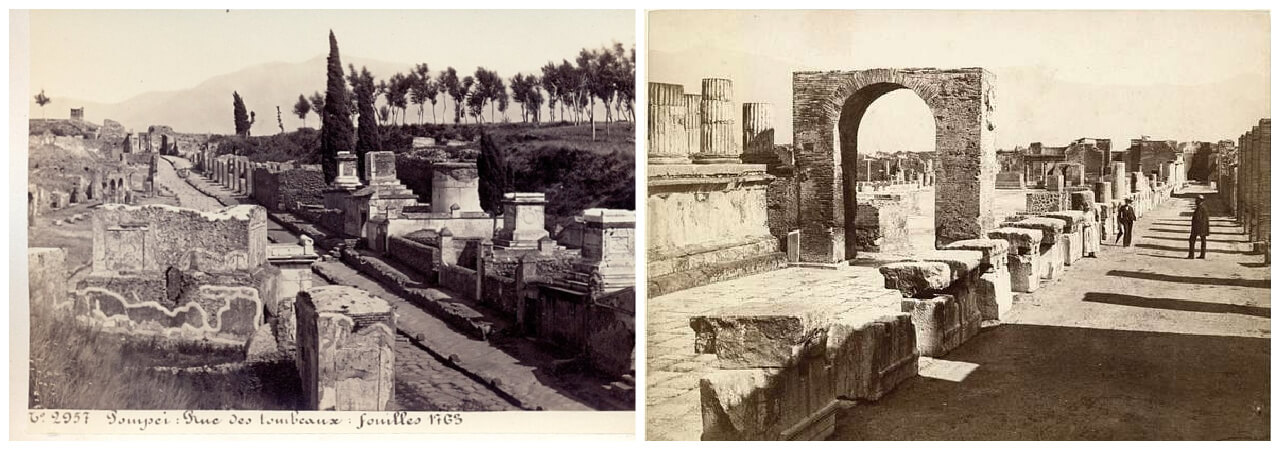
In 1860 Italian archaeologist Giuseppe Fiorelli became superintendent of Pompeii for 12 years from 1863 to 1875 and brought new techniques and organization to the ongoing excavation efforts. For example, he divided the area into different organized regions, opened the site to tourists with an entry fee, and used casting techniques of pouring plaster into voids in the ash left by decomposed organic material such as furniture, architectural elements, and victims of the eruption.
The casts of humans and animals remain to remind us of the tragic loss of life in Pompeii in 79 AD, and the great gift of Pompeii’s archaeology that made it possible for us to better understand this important event in Italy’s ancient history.
What can be learned about Ancient Roman life from the ruins of Pompeii?
Pompeii, along with Herculaneum and other similar archaeological sites, is of great importance for it provides a unique source of information regarding many aspects of the social, economic, religious, and political life of Ancient Rome.
The bakeries complete with mills and ovens (some still containing loaves of bread), thermopolia (an ancient version of fast food eateries), and garum factories document a culinary aspect of ancient life.
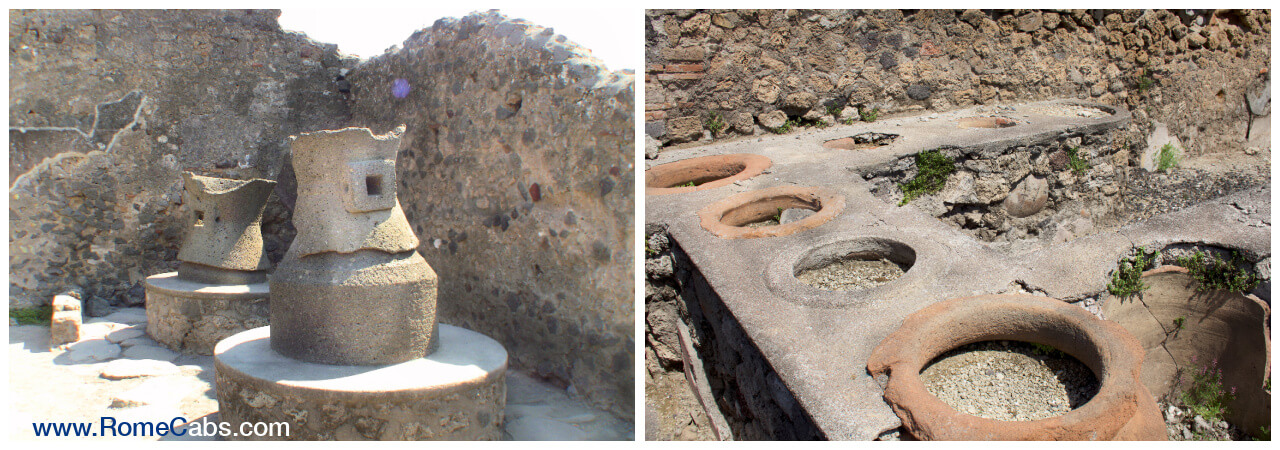
The many well-preserved homes offer a glimpse into the domestic life in an ancient Roman city. Lodging and inns existed for travelers and tradespeople at cheaper rates where the rooms were small and dark, and customers sat on stools. Attractive restaurants served food to patrons reclining in the garden.
Then there were fulleries that cleaned and processed wool, and various shops of sculptors, toolmakers, and gem cutters that make it possible to study these important industries that were part of everyday life in Ancient Rome. In addition, Pompeii offers one of the best opportunities to study ancient city planning and land use.
While the 19th century gifted us the knowledge of preserving the last moments of the victims of Mount Vesuvius in plaster casts, modern technology makes a leap forward. Utilizing X-ray machines, scientists were able to learn valuable information such as the individual’s gender, age, and overall health status. Modern, 3D scans and photogrammetry can build a real mode of the victim’s face with detailed facial expressions conveyed in their last moments of life.
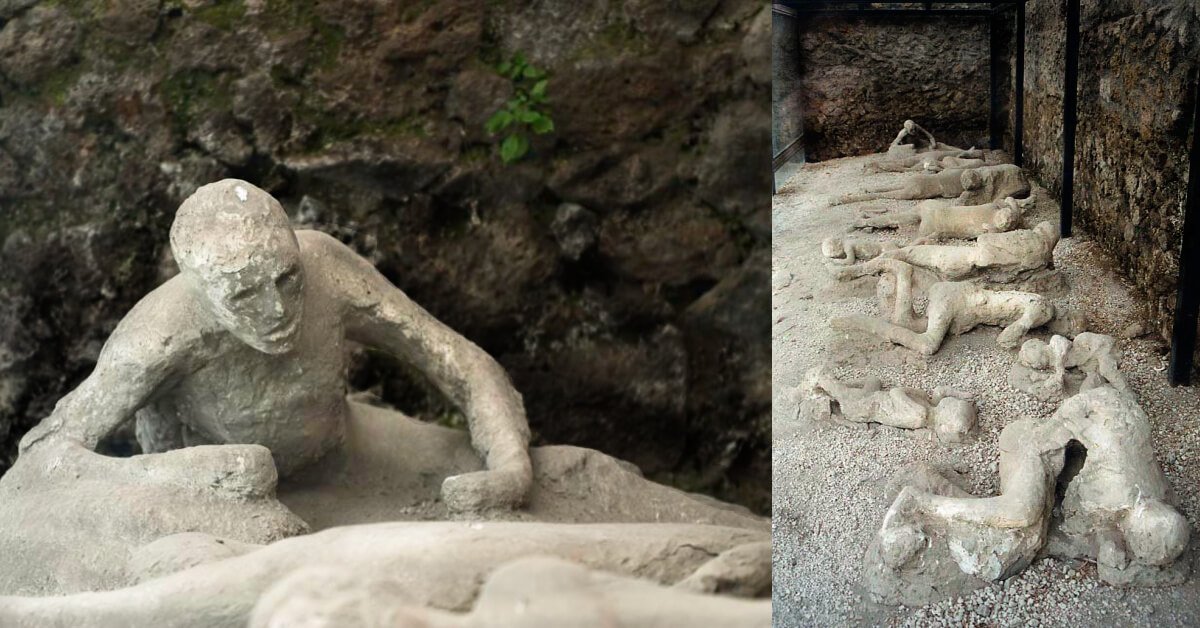
The skeletons of victims who perished offer new information as well. Medical scanning of casts has revealed that it was not just the weak and invalid who failed to escape Vesuvius’s destruction, but also the healthy and able-bodied. In one particular building, 13 healthy victims were discovered and studies suggested the victims included grandparents, parents, and their children (one of whom was a pregnant teenager).
By studying the wear on stone curbs made by carts brushing against them, Professor Eric Poehler from the University of Massachusetts (who has spent years studying the streets of this ancient city) established that Pompeii was comprised of a one-way street traffic system. Using 3D mapping technology made it possible to compile a grid of the transportation network demonstrating how people moved around the city.
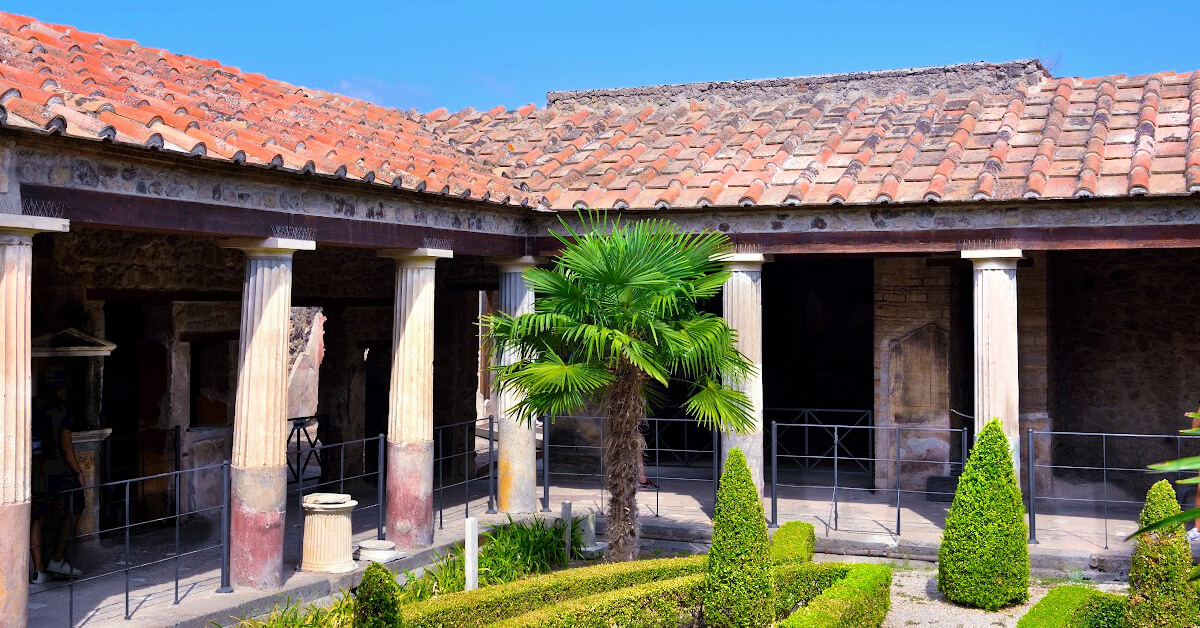
Studying latrines and trash may not be glamorous, but results yielded interesting discoveries of a rich and varied diet Pompeiians ate a staple Roman diet of songbirds, fish, sea urchins, shellfish, and pork. Breaking the meat into its molecular components revealed that some pigs were fed grains while others were fed meant. This is an indication that Pompeians raised livestock in ways that impacted the flavors of their food.
It has been gauged that at least a fifth of Pompeii was designated green space ranging from garden plots to orchards and vineyards. Elegant formal gardens with pools and fountains were enjoyed by the wealthy. Recent studies of wood, pollen, seeds, and other plant remains suggest Pompeians planted a large variety of trees, flowers, herbs, and vegetables.
How did Pompeii’s discovery influence the world?
Not only did Pompeii inspire Grand Tour travelers from Britain to visit Pompeii, Herculaneum, and Naples but also had a profound influence on European taste.
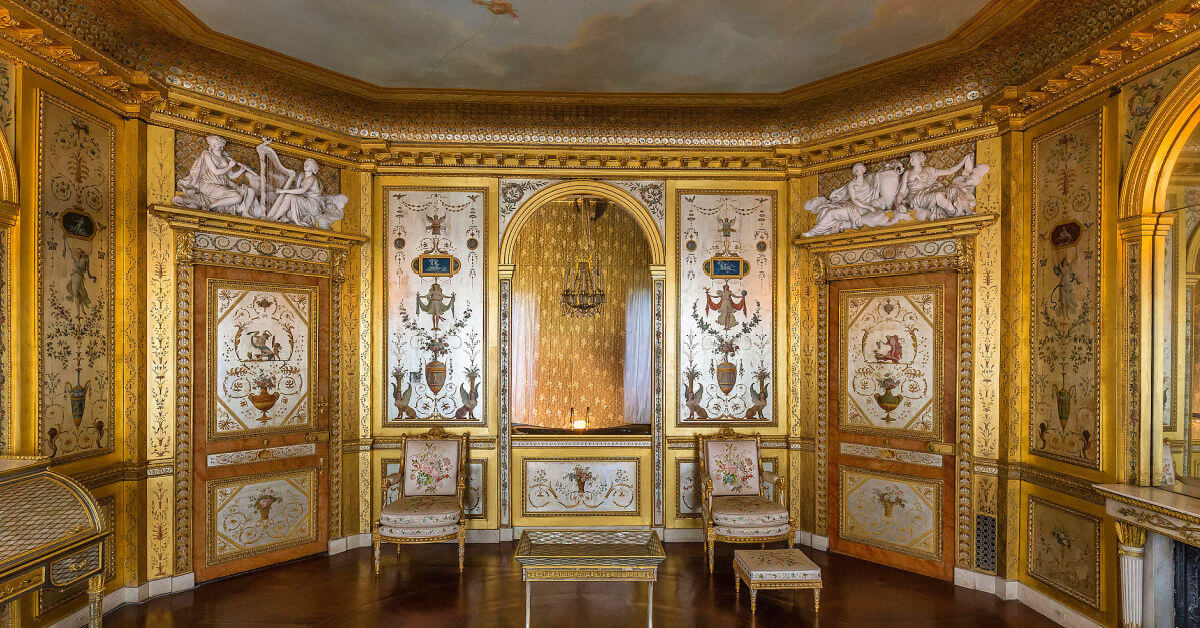
Artists, writers, potters, architects, and even furniture designers drew inspiration from discoveries at Pompeii. Interior wall colors and stucco mimicked frescoed walls discovered in the excavations. Late 18th century Louis XVI style of Neoclassicism that replaced Rococo incorporated Pompeian motifs and style that became popular throughout Europe.
The German writer Goethe wrote in his journal: “Of all the catastrophes which have been visited upon the world, few have bequeathed such enormous benefit to future generations.”
In 1997 the Archaeological areas of Pompeii (along with Herculaneum and Torre Annunziata) were declared a UNESCO World Heritage site.
The future outlook for Pompeii
Due to the efforts of countless archaeologists and researchers who worked diligently over the last three centuries to uncover many remains of Pompeii, we can again walk the streets of this fascinating ancient Roman town and imagine what life could have been like had we been suddenly transported in time. Vesuvius destroyed Pompeii 1,900 years ago, but unfortunately, this ancient city is tragically facing a second death.
The future of Pompeii is not written in stone. Its building walls, floors, and walls were intended to only last a few decades, not two centuries exposed to the ravages of weather, destructive vegetation, and millions of tourists each year. The task of restoring and protecting more than 15,000 buildings, five acres of wall paintings, and countless artifacts is daunting.
Despite efforts of conservation, Pompeii continues to face scores of problems such as degradation, mismanagement, and vandalism. The Italian government took an extraordinary measure in 2008 and declared a one-year state of emergency for Pompeii. A new special commissioner was appointed to oversee the site. Of utmost importance is the preservation, restoration, and study of the valuable objects already discovered before they are lost forever.
To continue preserving this world heritage, archaeologists are creating a digital Pompeii utilizing laser scanners that detail every inch of the city’s surface. It will take many years to complete this project, but the digital replica of Pompeii shared with experts around the world protects Pompeii from its cruelest fate yet: to once more vanish and be forgotten.
Why do people still live close to Mount Vesuvius today?
Throughout history, people still lived close to Mount Vesuvius primarily because of the fertile soil on the slopes of the volcano that creates a strong local agricultural economy.
Giuseppe Imbo, director of the Mt. Vesuvius Observatory, is quoted as saying, "A marvelous thing, my Vesuvius. It covers land with precious ash that makes the earth fertile and grapes grow, and wine. That's why, after every eruption, people rebuild their homes on the slopes of the volcano. That is why they call the slopes of Vesuvius the compania felix — the happy land."
Aside from agriculture, the area around Mount Vesuvius is quite splendid. All you have to do is visit the beautiful Campania region and see for yourself!
What grows on Mount Vesuvius
The slopes of Vesuvius are traditionally covered with orchards and vineyards that produce the local wine known as Lacrima Christi (Latin for “tears of Christ”). In ancient Pompeii, the ceramic wine jars were frequently marked with the name Vesuvinum.
Forests were also planted on the mountain slopes to protect inhabited places from mudslides that usually occur after violent eruptions. In the local fertile soil, trees and vegetation grow rapidly.
Can I hike to the top of Mount Vesuvius for a visit?
Yes! It is safe and fun to hike to the peak of Mount Vesuvius to admire the lunar crater rim. Don’t worry, you don’t have to start climbing from the base of the mountain.
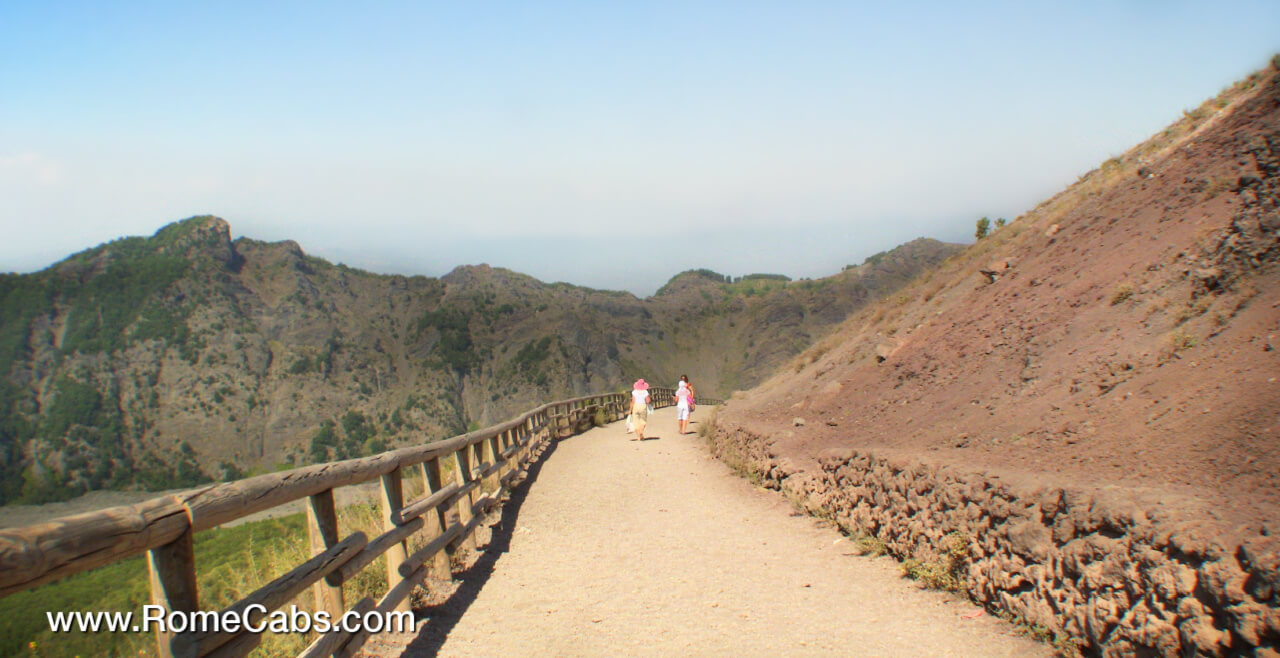
On tours to Mount Vesuvius, we take you as far to the top as possible which is marked by a parking area. From there, it’s a 20-30 minute walk along the pathway uphill at an incline to reach the summit of the crater. You’ll find lots of volcanic ash on the ground, so in addition to wearing sturdy footwear suitable for hiking, also make sure they can be easily cleaned off as ash will surely cover your shoes. A sturdy wooden railing along the edge of the cliff keeps climbers safe and offers support during their climb.
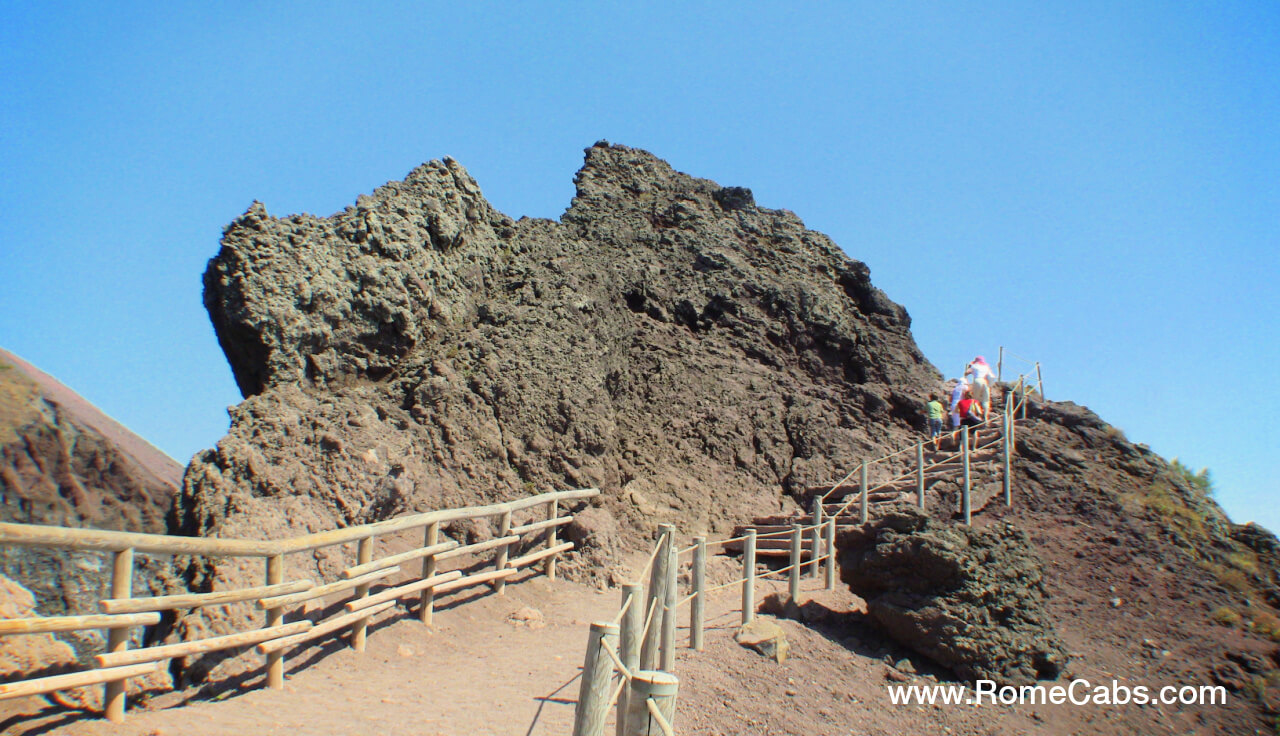
Feel free to stop and catch your breath if you are not an avid hiker, and admire the majestic beauty that surrounds you. When you consider the wonderment of being atop this magnificent volcano and your eagerness to reach its summit, you’ll find yourself arriving at the top of the mountain in no time!
The view of Naples and the Bay into the horizon from the top of Mount Vesuvius is one of the many rewards that await you. On clear sunny days, you may also be able to see the famous islands of Capri and Ischia in the distance. You will not find flowing lava or puffs of steam coming from Vesuvius’ crater, but that in itself is a welcome sight!
While face to face with Vesuvius’ lunar crater, take a moment to appreciate the overwhelming power of this volcano as you ponder the history that occurred here more than 1,900 years ago. At the very least it teaches us to appreciate each day to its fullest.
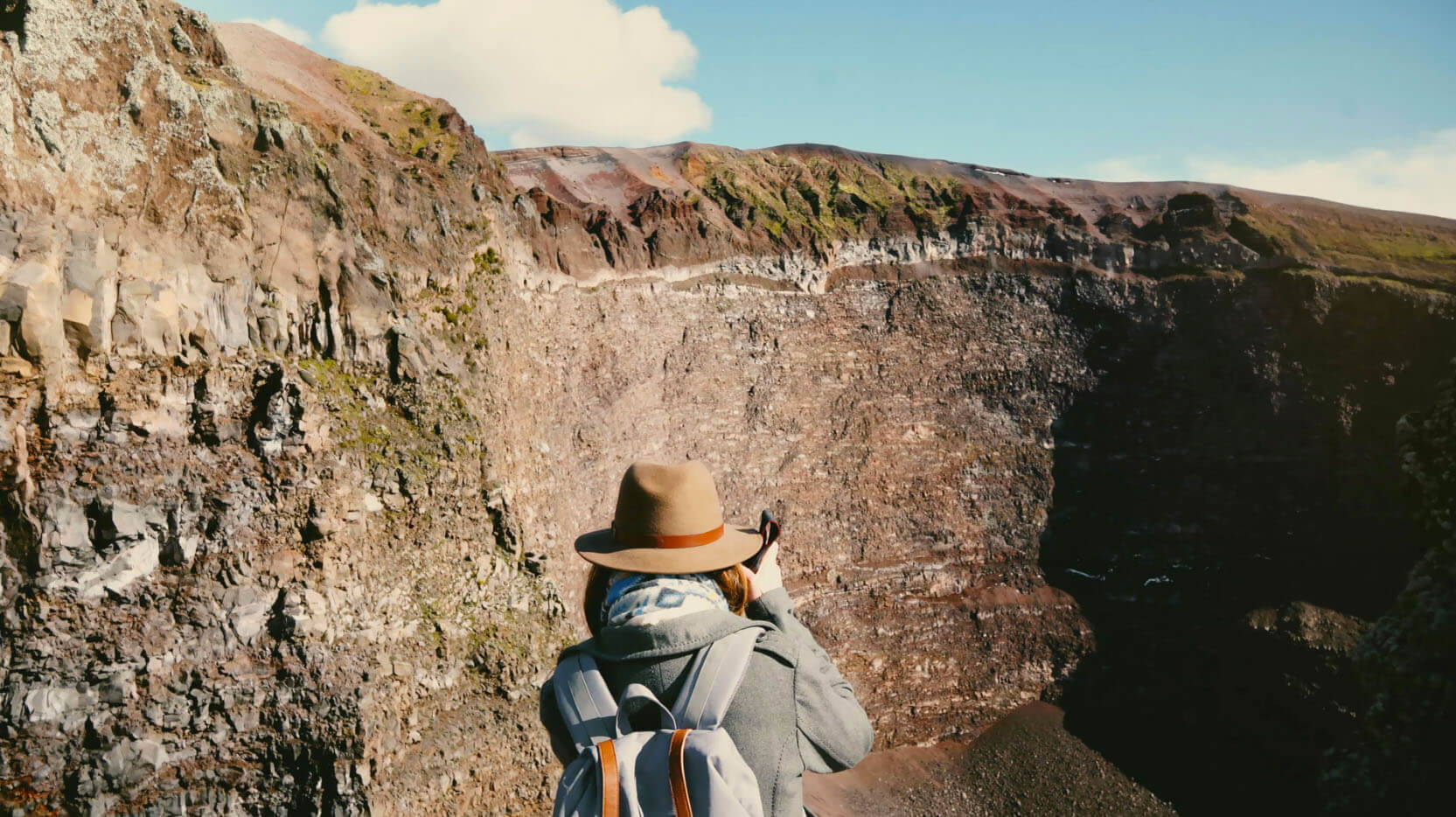
Mount Vesuvius will close during inclement weather conditions and winds that may make it unsafe to hike to the top.
Pompeii presents an amazing window into the past and provides an unparalleled look at life in the ancient Roman Empire. It’s truly a remarkable site that everyone should visit at least once in their lifetime.
Thank you for reading our What Volcano Destroyed Pompeii? The story of the ancient city of Rome travel blog.
Be sure to check out our Shore Excursions from Naples and Day tours from Rome to Pompeii and its magnificent region in Campania. We look forward to showing you beautiful places in Italy!
See what our clients say about our Pompeii and Amalfi Coast Tours from Rome and Shore Excursions from Naples:

ADDITIONAL Rome and Italy Travel Blogs:
-
3 Common Mistakes that Ruin Your Summer Trip to Rome
-
Is it Worth Paying More for a Private Tour from the Cruise Port?
-
TOP 7 ROME AND ITALY TRAVEL TIPS
Find us online also on:
